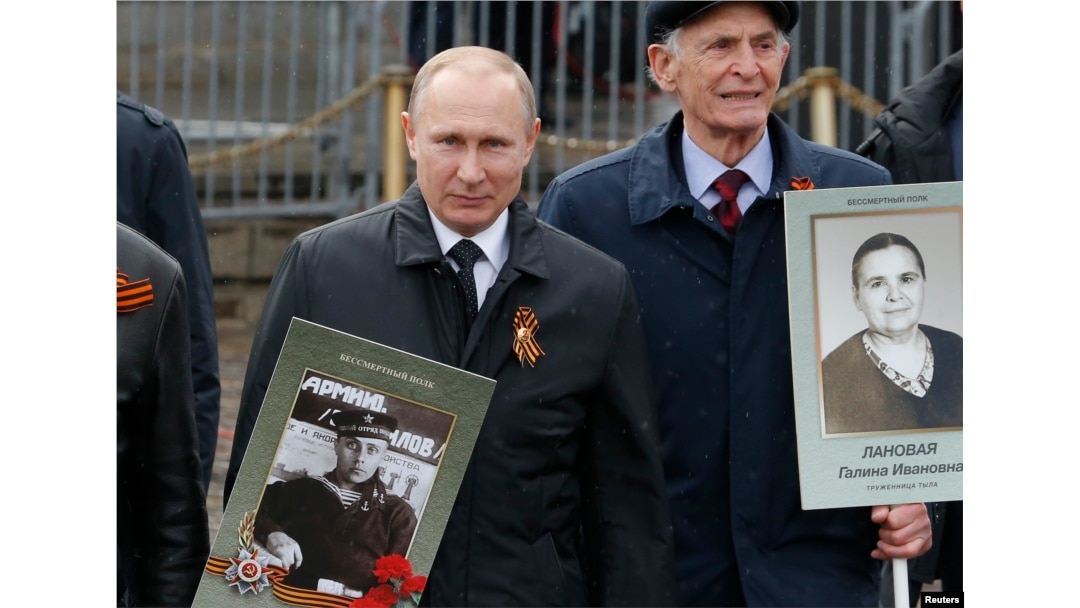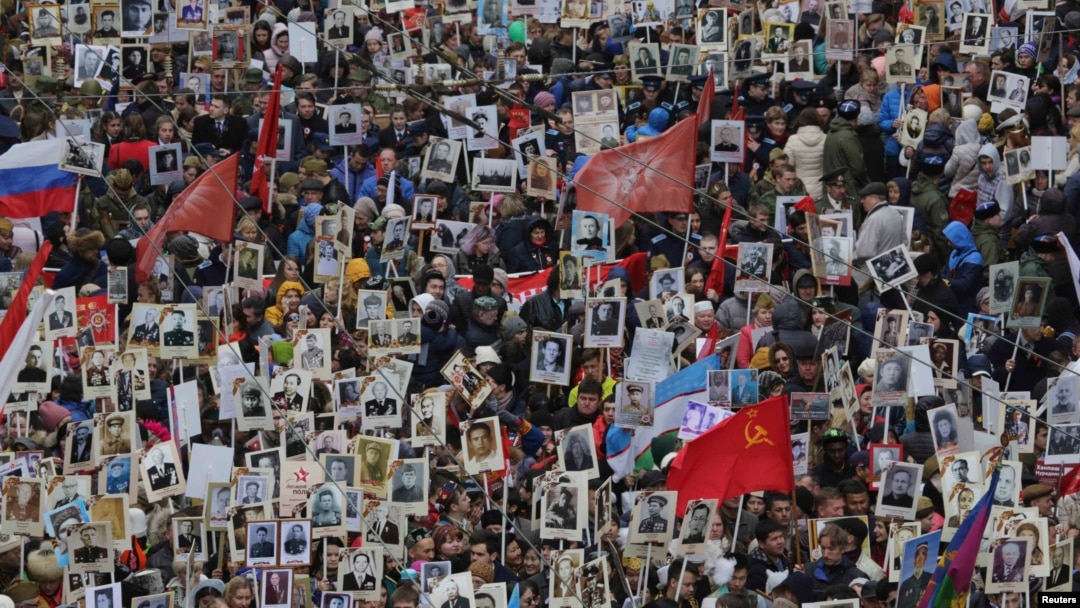With each passing year, the so-called Immortal Regiment procession marking the Soviet victory over Nazi Germany becomes larger and more widespread.
This year's event on May 9, Victory Day, saw an estimated 750,000 people out on the streets in Moscow and more than 8 million in cities across the country, according to Russian state media. Prompted by Russian embassies and Kremlin-friendly nongovernmental organizations, the Immortal Regiment movement this year also organized processions in more than 60 countries around the world, Rossia-1 television reported.
Since 2015, top Russian officials from President Vladimir Putin on down have participated in the procession, which is meant to evoke and honor the estimated 27 million Soviets who died during the war and those who lived to see victory.
But the Immortal Regiment has come under criticism by many who charge that people are participating without really understanding its meaning, carrying photographs of unknown people handed to them by organizers and quickly discarded after the event.
"The Immortal Regiment was doomed from the moment of its birth," prominent blogger and former Duma Deputy Igor Yakovenko wrote on May 10. "The likelihood that the authorities would tolerate an independent grassroots movement that was becoming national and even international was precisely zero. The transformation of a grassroots initiative into a state ritual and part of the quasi-religious cult of 'victory' began already in 2014.... That was the end of the human story of the Immortal Regiment and the beginning of the story of a state ritualistic cult."
Show Of Gratitude
Over the last few years, Putin's government has increasingly staked its domestic prestige on a seemingly narrow and strictly controlled vision of patriotism, and the interpretation of the Soviet experience of World War II has become the cornerstone of that effort.

Russian President Vladimir Putin holds a portrait of his father, Vladimir Spiridonovich, as he takes part in the Immortal Regiment march in Moscow on May 9.
The Soviet Union and Russia have long had a difficult time figuring out how to remember the war against Nazi Germany. Under dictator Josef Stalin, the official death toll was placed at just 7 million. Victory Day was not marked as an official holiday until 1965, after the number of people with direct memories of the conflict had fallen significantly. Issues such as the Molotov-Ribbentrop pact, the horrendous Soviet losses in the early days of the war, the significance of British and U.S. assistance provided through the Lend-Lease program, atrocities committed by the Red Army in Germany, Stalin's policy of sending many returning prisoners of war off to the GULAG, and many other facts complicate the telling of a somber story.
The idea of the Immortal Regiment was born among three friends sharing a solemn moment near the Eternal Flame monument in the Siberian city of Tomsk in 2011.
"The idea occurred to my colleague Igor Dmitriyev, who now lives in St. Petersburg," one of the men, Tomsk journalist Sergei Lapenkov, told RFE/RL's Russian Service. "[Victory Day] was always really important for us. We were all the grandsons of soldiers; all our grandfathers fought. And Igor noticed what the passage of time was doing -- there were fewer and fewer veterans and more and more pompous speeches. So he said, 'Next year let's organize a parade with portraits of our grandfathers.' We wanted to return the holiday to the main hero -- to the person who experienced the war and to whom we are ultimately grateful for the fact that we are alive today. That may sound a little pathetic, but that's exactly how we felt."
Lapenkov's grandfather, Ivan Lapenkov, fought in both the Winter War against Finland and the war against Nazi leader Adolf Hitler. He was awarded the Hero of the Soviet Union medal and returned home disabled.
"Thanks to my grandfather, for a long time I thought it was normal that if a man is a soldier and comes back from a war, then he has either no legs or no arms," Lapenkov says. Ivan Lapenkov died in 1974, when his grandson was 6 years old.
The purpose of the procession from the beginning was to pay tribute to the generation that endured the war.
"It wasn't about the history, in the direct sense, of the army and the navy," Lapenkov says. "For us it was a generational history, the history of all the people who went through the 1940s. It was about human memory.... Every grandfather had a grandmother. She waited. She raised the children. When you get down to it, he mustered himself to attack for her sake."
From Grassroots Movement...
The next year, 2012, the three men took their idea public and it clearly struck a chord. About 6,000 locals turned out with portraits.
"The first year, we had 2,000 official placards made up," Lapenkov says, "plus a lot of people came with their homemade placards or just carrying photographs. I saw one guy who made a placard out of a child's shovel. He glued a laminated photograph to it and it worked out very nicely for him."
Sergei Lapenkov
Over the next few years, the Immortal Regiment movement spread to other Russian cities as a genuine grassroots movement. As a rule, Lapenkov recalls, local authorities were supportive and did not interfere. In the city of Kemerovo, officials told organizers that they had to march with the banner of the ruling United Russia party -- a condition that was rejected.
In other cities, officials denied permission for the procession because organizers were unable to predict in advance how many people would show up. Generally, local processions were organized by independent regional journalists through networks tied to the original Tomsk organizers.
The only condition, Lapenkov says, was that the local organizations follow the Tomsk lead and remain "noncommercial, apolitical, and nongovernmental."
"This is aimed at preventing the regiment from becoming a promotional tool for any force or personality," he says. Shortly after the 2012 debut, United Russia approached Lapenkov's group with a proposal to create a national project. Lapenkov was able to put them off, and nothing came of the proposal.
...To 'Mandatory Patriotism'
In 2013, the Immortal Regiment procession was held for the first time in Moscow. One of the local organizers, Nikolai Zemtsov, independently registered a new organization called Immortal Regiment-Moscow. The following year, an order emerged from then-Kremlin chief of staff Sergei Ivanov, instructing all local officials across the country to support Zemtsov's movement.
In 2015, Zemtsov's group was renamed Immortal Regiment-Russia. "At some point, apparently, they made a decision not to have anything to do with a grassroots organization," Lapenkov says. "They just built their own organization."
"Through the Public Chamber of the Russian Federation [a Kremlin-organized advisory body] and the All-Russia People's Front [a political movement set up by Putin], some activists appeared in the regions; and these people created the Immortal Regiment-Russia," he explains. "Our coordinators were not included. Not one volunteer from the grassroots organizations. And that is how Immortal Regiment-Russia appeared -- a completely artificial organization."
Immediately, Lapenkov says, his volunteers noted concerning trends. In Samara, schools were presented with quotas of required participation in the march. In Nizhny Novgorod, students reported being forced to carry photographs of unknown people. In far eastern Krasnoyarsk, the procession was held at the same time as the Moscow event, apparently so marchers could participate "together" with Putin.
In Arkhangelsk, officials barred activists from carrying the photographs of British and U.S. sailors who died providing Lend-Lease supplies to the Soviet Union, citing the current "political situation."
"It became a case of the very 'mandatory patriotism' to which Immortal Regiment was created as an alternative," he says.
Sergei Lapenkov: "We wanted to return the holiday to the main hero -- to the person who experienced the war and to whom we are ultimately grateful for the fact that we are alive today."
The new state-controlled movement was also responsible for the dramatic increase in the use of Soviet and Stalinist symbols and for the mass distribution of the orange-and-black St. George's ribbon.
At the same time, the original Immortal Regiment organizers have been regularly denounced in nationalist media as "foreign agents," a label with echoes of Soviet-era repression that has been used against select NGOs since 2012.
"[Victory Day] always had a lot of official pomposity," Moscow journalist Boris Minayev tells RFE/RL, "but we were always able to separate our personal feelings from that pomposity.... Now it has become harder to do that because the holiday has become suffused with something else. It was always a holiday of memory, of mourning. A holiday full of pain, a holiday with tears in our eyes, as the poet said so well. But now it is full of aggression."


